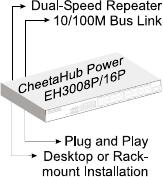
Quick Installation Guide
1
1
Introduction
The CheetaHub Power-3008P/16P provides 8 (16) RJ-45
ports that automatically adjust to the speed of the
attached device (for 10Mbps Ethernet or 100Mbps Fast
Ethernet connections). These dual-speed hubs contain
two internal repeater buses – one for 10Mbps traffic and
another for 100Mbps traffic. Traffic passing between
attached devices that operate at the same speed is confined
within the appropriate repeater bus. But when traffic must pass
between 10 and 100Mbps devices, when the destination address is not found in
the address table, or broadcast traffic is sent, data is forwarded to the other
repeater bus via an internal 10/100Mbps switch.
These hubs provide an ideal bridge between 10 and 100Mbps Ethernet networks.
Moreover, the smart design built into the display panel provides a friendly
interface that simplifies installation and network troubleshooting.
Installing the Hub
Before installing the hub, please verify that you have all the items listed under
“Package Contents.” If any of the items are missing or damaged, contact your
local Accton distributor. Also be sure you have all the necessary tools and
cabling before installing the hub. Note that this hub can be installed on any
suitably large flat surface or in a standard EIA 19-inch rack.
Package Contents
The CheetaHub Power-3008P/16P includes:
• CheetaHub Power-3008P (Model No. EH3008P)
Fast Ethernet dual-speed hub with 8 10/100Mbps ports, and internal switch
or CheetaHub Power-3016P (Model No. EH3016P)
Fast Ethernet dual-speed hub with 16 10/100Mbps ports, and internal switch
• Four rubber foot pads • Quick Installation Guide
• Rack mount bracket kit • Owner registration card
• AC power cord
Description of Hardware
These hubs provide 8 (16) dual-speed ports (10/100 Mbps). Each port
automatically senses the speed of the attached device, and channels data to the
appropriate repeater bus. The learning function of the hub stores the node
address and corresponding segment number (i.e., bus 1 or 2) of each incoming
packet in a routing table. If the source and destination node operate at different
speeds, this information is subsequently used to pass traffic to the segment


















